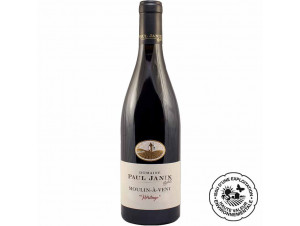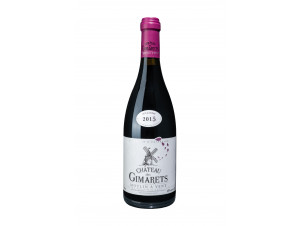You have no items in your shopping cart.
Wine Moulin-à-Vent
The Moulin-à-Vent appellation is one of the 10 Crus of Beaujolais. The wines of this appellation are often considered as the best of the Beaujolais! They offer aromatic characteristics very typical of their terroir, located between Burgundy and the Rhone Valley, wines with charm and structure. Read more on Moulin-à-Vent
-
Top Selling-20%
-
Top Selling
-
Top Selling
- -27%
- -25%
- -24%
- -15%
- -25%
- -10%
Appellation Moulin-à-Vent
The name "Moulin-à-Vent" comes from a... Windmill!
Like many French regions, the Beaujolais region was occupied by the Roman colonies, which therefore imported the cultivation of the vine. We must not forget that we owe them the arrival of wine on our territory! In certain texts of the time, we find mention of a grape variety, called Allobrogica by the Romans, which is probably the ancestor of Pinot Noir. Later, the region was invaded by barbarian peoples from new horizons, who in turn brought new grape varieties.
This is how the Gouais Blanc came to the region. Genetic research has since shown that it was the crossing of Gouais and Pinot Noir that gave rise to Gamay, the most widely used grape variety in the Moulin-à-Vent appellation, but also in the whole of Beaujolais.
During the Middle Ages and the Renaissance, Moulin-à-Vent wines spread throughout the region, thanks to the Saône River, which allowed goods to be transported to the city of Lyon and its surroundings. The geographical proximity of Beaujolais to Burgundy partly explains why, in 1930, Beaujolais was considered to belong to Burgundy.
However, as this decision was controversial, the situation changed in 1936, when 5 decrees marked the creation of 5 Beaujolais appellations: Chénas, Chiroubles, Fleurie, Moulin-à-Vent and Morgon. Julienas, Brouilly, Côtes de Brouilly, Saint-Amour and the AOC Beaujolais Villages followed. These 10 AOCs still form the 10 Crus du Beaujolais today.
The Moulin-à-Vent AOC covers 665 hectares. It is a relatively small AOC. The appellation partly covers 2 communes: Chénas and Romanèche-Thorins, and therefore straddles the Rhône and Saône-et-Loire departments. This appellation takes its name from the windmill, located in the heart of the vineyard, and classified as a historical monument.
The alliance of Gamay and granite: a winning combination for the Moulin-à-vent
The soils and subsoils of the appellation are mostly made up of Fleurie granite, a pink granite known locally as "roche pourrie". There are also many traces of sediments, such as sand, gravel and pebbles, which were deposited by the Saône in the faults of the soil and subsoil.
Some parcels of the AOC are particularly suitable for growing grapes, and have therefore been listed as "climats": Le Clos, le Carquelin, Champ de Cour, les Rouchaux, en Morperay, les Burdelines, la Roche, la Delatte, les Bois Maréchaux, la Pierre, les Joies, Rochegrès, la Rochelle, Champagne, les Caves, Grenerier, Plantier Favre and les Vérillats. These parcels are therefore the most beautiful in the appellation.
Gamay, as mentioned above, is the main grape variety cultivated and authorised in the Moulin-à-vent appellation, and more widely in all the Beaujolais Crus. It is a black grape variety, so its skin is dark, but its flesh is light. This is the case for the majority of black grape varieties. The specifications authorise the cultivation and use of three other grape varieties up to 15% in the final blend: Aligoté, Chardonay and Melon. These are three white, white-fleshed grape varieties.
The particularity of the Moulin-à-Vent AOC wines, and of Beaujolais in general, is the carbonic maceration. This is a maceration that takes place just after the harvest: the bunches of grapes are placed in vats, whole. The grapes at the bottom are crushed and alcoholic fermentation begins. Carbon dioxide is then released into the closed vat and protects the rest of the grapes in the vat. Fermentation (transformation of sugars into alcohol) thus begins inside the grape berry, and allows the wine to retain fresh fruit aromas and fairly soft, light tannins.
Characteristics of the Moulin-à-vent vineyard
To the eye, the wines of the Moulin-à-Vent appellation have a garnet to ruby colour. The colour is intense and very deep, which is very characteristic of the appellation.
On the nose, the aromas are quite intense, and are often a mixture of flowers and fruit, mostly violet and cherry. With age, these aromas become more complex and concentrated. We then find aromas of iris, spices, rose, ripe fruit, and finally musk or truffle.
On the palate, the wine is very fleshy and tannic, quite spicy, and very harmonious between the structured tannins and the very fruity side of the wine as a whole.
These wines should be served at a temperature of around 16°C. It is possible to keep the best vintages for decades, but generally it is advisable to keep them between 5 and 10 years.
What to drink Moulin-à-vent with?
These wines go very well with meat dishes in sauce, such as coq au vin, daubes, grilled tournedos, game such as pheasant and wild boar. These are powerful wines that will stand up to many dishes that are quite strong in the mouth. They go very well with the most aromatic cheeses such as Epoisses, Munster or very mature Camemberts.
Moulin-à-Vent : the domains to discover
Domaine Olivier Merlin
This estate is worked in the traditional way, with as few chemical inputs as possible, and it is even a horse that ploughs the rows between the vines. This very spicy wine embodies the appellation very well, with its balance between power and fruit.Domaine Bertrand
The 2 hectares of vines on this estate produce very elegant, fine, spicy and powerful wines. The vines are over 50 years old and give this wine incredibly complex aromas.
Beaujolais et Lyonnais appellations



































 TWIL - Achat de Vin
TWIL - Achat de Vin


